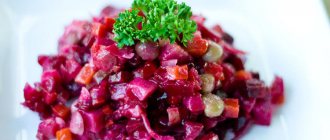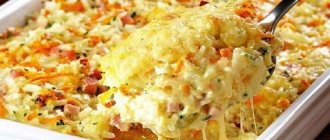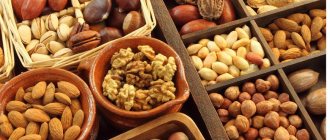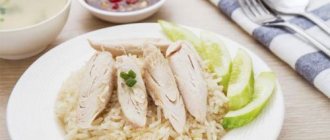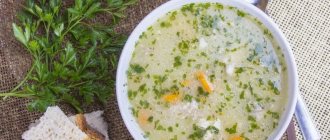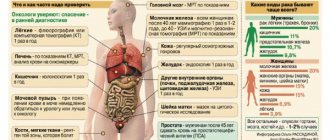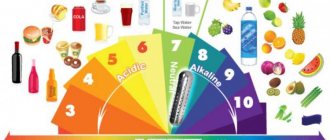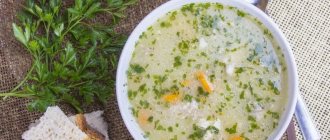Medical editor: Zemereva N.Yu., physiotherapist
Flatulence is a condition when gas formation in the intestines is increased, and the removal of gases from it is difficult. Due to increased gas production, the abdomen “swells”, which leads to pain.
Flatulence, as a rule, is only one of the symptoms of diseases of the gastrointestinal tract, so it is necessary to find out the cause of its occurrence. However, in many cases, following a diet helps to neutralize the manifestations of this pathology.
General rules
The term “intestinal flatulence” means an increased content of gases in the intestines and the resulting symptom complex in the form of rumbling, a feeling of heaviness and distension in the abdomen, an increase in its volume, frequent and often involuntary passage of gases, causing the patient significant discomfort. Increased gas content promotes intestinal distension and stimulates peristalsis , causing pain.
Severe flatulence can affect the patient’s mental state, disrupt normal lifestyle, and cause restlessness, anxiety and depression . The gastrointestinal tract of an adult normally contains about 200 ml of various types of gases (nitrogen, hydrogen sulfide, carbon dioxide, methane, oxygen, ammonia), which are enclosed in bubbles of various sizes and evenly distributed throughout the mass of chyme.
The main ways gas enters the body and the reasons for its increased formation in the intestines are:
- aerophagia (increased swallowing of air) when eating with an incorrect diet (talking at the table, fast food, chewing gum, drinking carbonated drinks);
- high metabolic activity of microflora, mainly in the large intestine, caused by excessive consumption of foods that cause increased gas formation and enhance fermentation processes, as well as disruption of the processes of digestion/absorption in the small intestine and the entry of undigested proteins, fiber, and complex carbohydrates into the large intestine;
- development of dysbacteriosis ;
- disruption of nutrient absorption;
- decreased intestinal motility, enzymatic deficiency (usually lactose), the presence of mechanical obstacles in the intestines - feces due to constipation , tumors;
- stagnation of blood in the intestinal area.
Thus, the causes of flatulence , in addition to poor nutrition, can be chronic liver diseases, intestinal dysbiosis , pancreatitis with enzyme deficiency, intestinal diseases ( enteritis , colitis ), irritable bowel syndrome. It is extremely important to understand the cause of flatulence in each specific case, for which the patient should undergo examination.
In any case, one of the ways to treat flatulence and reduce the manifestation of characteristic symptoms is to adjust nutrition and switch to a diet. The main goals of the diet for increased gas formation in the intestines are:
- focus on reducing putrefactive and fermentative processes in the intestines by excluding from the diet foods that cause increased gas formation and fermentation processes (legumes, baked goods, carbonated drinks, honey, some cereals, black bread, sweet fruits and others);
- exclusion from the diet of foods to which there is food intolerance (dairy products);
- providing physiologically adequate nutrition;
- restoration of normal intestinal microflora (taking probiotics );
- normalization of intestinal motility.
But in each case of flatulence, therapeutic nutrition is prescribed individually, taking into account physiological characteristics and the presence of diseases of the digestive tract. Quite often, flatulence is caused by errors in nutrition and regimen, which can be completely eliminated.
Basic principles of therapeutic nutrition:
- Eating should take place without talking in a calm environment with thorough chewing, all kinds of snacks “on the run” are excluded.
- Avoid taking liquids during meals; drink only between meals.
- Meals are fractional, up to 5-6 times a day, preferably at a certain time and in small portions.
- Avoid chewing gum and drinking liquids through straws.
- Food is consumed warm; hot and cold foods are not allowed.
- It is necessary to avoid taking mutually exclusive foods, for example, salty and sweet, milk and vegetable fiber, proteins and carbohydrates. Fruits can only be consumed separately, an hour after meals.
- Culinary processing involves sparing the gastrointestinal tract, so dishes are steamed, or served stewed, boiled or baked.
- The drinking regime is at least two liters per day of free liquid, which promotes the timely evacuation of feces and prevents fermentation.
- Salt is limited to 6-8 grams to reduce gastrointestinal irritation.
The energy value of the diet is about 2200-2500 Kcal, the consumption of fats and carbohydrates, especially simple ones, is slightly reduced.
Nutrition for irritable bowel syndrome with flatulence
Irritable bowel syndrome is manifested by diarrhea and flatulence, and is classified as a functional change. However, the body loses water, electrolytes, and undigested nutrients.
The composition of the daily menu must correspond to the physiological norm
Features of recommendations:
- the amount of vegetable fats increases due to oils (olive, sunflower, flaxseed);
- coarse dietary fiber from cereals (buckwheat, pearl barley, millet) is added;
- Extractive substances and essential oils (seasonings, herbs, mustard, horseradish) are excluded;
- animal fats with a high cholesterol content are limited (meat, sausages, jellied meat, rich broths);
- protein is added through lean chicken meat;
- All foods that stimulate peristalsis are prohibited (carrots, beets, prunes, dried apricots, raw fruits);
- limit light carbohydrates by prohibiting grape and apple juice, bananas, and nuts.
Authorized Products
A diet for flatulence in adults includes the inclusion in the diet of clear, weak broths based on lean meat or chicken and soups based on them. Lean meat (veal, beef) and turkey, chicken, rabbit, steamed or boiled are allowed. The diet may include low-fat boiled fish (perch, cod, pike perch, pike), chicken eggs in the form of a steam omelet or soft-boiled, vegetable oil, crackers made from wheat flour or dried bread.
Vegetables - boiled potatoes, beets, carrots, pumpkin, zucchini, dill, parsley, bay leaf, caraway seeds. For flatulence in adults, mucous or pureed porridges with water are allowed: semolina, buckwheat, rice, oatmeal.
Dairy products include pureed cottage cheese, low-fat kefir, and yogurt. The drinking regime is supported by the inclusion in the diet of still drinking water, tea (green, herbal), dill water, decoctions of blueberries, bird cherry, and rose hips.
Table of permitted products
| Proteins, g | Fats, g | Carbohydrates, g | Calories, kcal | |
Vegetables and greens | ||||
| mashed potatoes | 2,5 | 4,2 | 14,7 | 106 |
| boiled carrots | 0,8 | 0,3 | 5,0 | 25 |
| boiled beets | 1,8 | 0,0 | 10,8 | 49 |
Fruits | ||||
| apricots | 0,9 | 0,1 | 10,8 | 41 |
| peaches | 0,9 | 0,1 | 11,3 | 46 |
Cereals and porridges | ||||
| viscous buckwheat porridge on water | 3,2 | 0,8 | 17,1 | 90 |
| semolina porridge on water | 2,5 | 0,2 | 16,8 | 80 |
| white boiled rice | 2,2 | 0,5 | 24,9 | 116 |
Bakery products | ||||
| white bread crackers | 11,2 | 1,4 | 72,2 | 331 |
Confectionery | ||||
| cracker cookies | 11,3 | 13,4 | 67,1 | 352 |
Dairy | ||||
| dairy products | 3,2 | 6,5 | 4,1 | 117 |
Cheeses and cottage cheese | ||||
| cottage cheese 0.6% (low fat) | 18,0 | 0,6 | 1,8 | 88 |
Meat products | ||||
| boiled beef | 25,8 | 16,8 | 0,0 | 254 |
| veal | 19,7 | 1,2 | 0,0 | 90 |
| rabbit | 21,0 | 8,0 | 0,0 | 156 |
Sausages | ||||
| boiled diet sausage | 12,1 | 13,5 | 0,0 | 170 |
Bird | ||||
| boiled chicken breast | 29,8 | 1,8 | 0,5 | 137 |
| boiled chicken fillet | 30,4 | 3,5 | 0,0 | 153 |
| boiled turkey fillet | 25,0 | 1,0 | — | 130 |
Eggs | ||||
| omelette | 9,6 | 15,4 | 1,9 | 184 |
| soft-boiled chicken eggs | 12,8 | 11,6 | 0,8 | 159 |
Fish and seafood | ||||
| boiled fish | 17,3 | 5,0 | 0,0 | 116 |
| zander | 19,2 | 0,7 | — | 84 |
| cod | 17,7 | 0,7 | — | 78 |
| pike | 18,4 | 0,8 | — | 82 |
Oils and fats | ||||
| vegetable oil | 0,0 | 99,0 | 0,0 | 899 |
Non-alcoholic drinks | ||||
| green tea | 0,0 | 0,0 | 0,0 | — |
| black tea | 20,0 | 5,1 | 6,9 | 152 |
| * data is per 100 g of product | ||||
Sample diet menu No. 4
- First breakfast: steamed fish cutlets (130 g), mashed rice porridge with water (280 g), tea (200 g).
- Second breakfast: cottage cheese (100 g).
- Lunch: pureed meat soup (400 g), meatballs without side dish, rosehip decoction (200 g).
- Afternoon snack: wheat bread crackers with sugar from the daily norm (200 g), rosehip decoction (200 g).
- Dinner: steam omelette (130 g), semolina porridge with meat broth (300 g).
- At night: dried blueberry jelly (180 g).
- For the whole day: wheat bread crackers (100 g), sugar (40 g), butter (10 g).
A medical diet is prescribed only by the attending physician , who has full knowledge of the medical history of a particular patient.
Fully or partially limited products
In case of flatulence, proper nutrition is ensured by completely excluding from the patient’s diet all fatty meats, animals (lard, sour cream, cream, butter) and cooking fats, marinades, canned food, smoked meats and pickles.
The consumption of all legumes (lentils, beans, peas, beans) is not allowed, since they cause increased gas formation in the intestines, coarse porridges (oatmeal, pearl barley, millet), mushrooms, hard-boiled or fried eggs, mayonnaise, fatty fish, pasta, dumplings, dumplings, some vegetables (all types of cabbage, turnips, onions, rutabaga, garlic), soybeans, corn, products made from yeast dough, and rye flour, hot and spicy spices, all types of nuts and seeds, confectionery (cookies, cakes, cakes, sweets), dried fruits and especially raisins, honey, jam, jam, sugar, sweet fruits (peaches, pears, bananas, tangerines, grapes, apples), chocolate, cocoa, beer, carbonated drinks, kvass, alcohol-containing drinks.
Table of prohibited products
| Proteins, g | Fats, g | Carbohydrates, g | Calories, kcal | |
Vegetables and greens | ||||
| beans | 6,0 | 0,1 | 8,5 | 57 |
| peas | 6,0 | 0,0 | 9,0 | 60 |
| daikon | 1,2 | 0,0 | 4,1 | 21 |
| broccoli | 3,0 | 0,4 | 5,2 | 28 |
| Brussels sprouts | 4,8 | 0,0 | 8,0 | 43 |
| red cabbage | 0,8 | 0,0 | 7,6 | 24 |
| cauliflower | 2,5 | 0,3 | 5,4 | 30 |
| fried potato | 2,8 | 9,5 | 23,4 | 192 |
| bulb onions | 1,4 | 0,0 | 10,4 | 41 |
| chickpeas | 19,0 | 6,0 | 61,0 | 364 |
| radish | 1,2 | 0,1 | 3,4 | 19 |
| white radish | 1,4 | 0,0 | 4,1 | 21 |
| turnip | 1,5 | 0,1 | 6,2 | 30 |
| soybeans | 34,9 | 17,3 | 17,3 | 381 |
| beans | 7,8 | 0,5 | 21,5 | 123 |
| horseradish | 3,2 | 0,4 | 10,5 | 56 |
| garlic | 6,5 | 0,5 | 29,9 | 143 |
Fruits | ||||
| oranges | 0,9 | 0,2 | 8,1 | 36 |
| bananas | 1,5 | 0,2 | 21,8 | 95 |
| cherry | 0,8 | 0,5 | 11,3 | 52 |
| grapefruit | 0,7 | 0,2 | 6,5 | 29 |
| lemons | 0,9 | 0,1 | 3,0 | 16 |
| apples | 0,4 | 0,4 | 9,8 | 47 |
Berries | ||||
| grape | 0,6 | 0,2 | 16,8 | 65 |
| currant | 1,0 | 0,4 | 7,5 | 43 |
Mushrooms | ||||
| mushrooms | 3,5 | 2,0 | 2,5 | 30 |
Nuts and dried fruits | ||||
| nuts | 15,0 | 40,0 | 20,0 | 500 |
| dried fruits | 2,3 | 0,6 | 68,2 | 286 |
| raisin | 2,9 | 0,6 | 66,0 | 264 |
| dates | 2,5 | 0,5 | 69,2 | 274 |
Snacks | ||||
| potato chips | 5,5 | 30,0 | 53,0 | 520 |
| salted popcorn | 7,3 | 13,5 | 62,7 | 407 |
Cereals and porridges | ||||
| porridge with milk | 3,3 | 2,9 | 17,4 | 105 |
| oat bran | 8,0 | 4,0 | 10,0 | 110 |
| pearl barley porridge | 3,1 | 0,4 | 22,2 | 109 |
| millet porridge | 4,7 | 1,1 | 26,1 | 135 |
| boiled brown rice | 2,6 | 0,9 | 22,8 | 110 |
| barley porridge | 11,5 | 2,0 | 65,8 | 310 |
| rye bran | 11,2 | 3,2 | 32,0 | 221 |
Flour and pasta | ||||
| pancakes | 6,1 | 12,3 | 26,0 | 233 |
| vareniki | 7,6 | 2,3 | 18,7 | 155 |
| pancakes | 6,3 | 7,3 | 51,4 | 294 |
| dumplings | 11,9 | 12,4 | 29,0 | 275 |
Bakery products | ||||
| loaf with wheat bran | 9,2 | 2,8 | 51,4 | 273 |
| buns | 7,9 | 9,4 | 55,5 | 339 |
| rye-wheat bread | 8,1 | 3,4 | 42,2 | 222 |
Confectionery | ||||
| candies | 4,3 | 19,8 | 67,5 | 453 |
| cake | 3,8 | 22,6 | 47,0 | 397 |
| halva | 11,6 | 29,7 | 54,0 | 523 |
Cakes | ||||
| cake | 4,4 | 23,4 | 45,2 | 407 |
Chocolate | ||||
| chocolate | 5,4 | 35,3 | 56,5 | 544 |
Raw materials and seasonings | ||||
| seasonings | 7,0 | 1,9 | 26,0 | 149 |
| mayonnaise | 2,4 | 67,0 | 3,9 | 627 |
Dairy | ||||
| milk | 3,2 | 3,6 | 4,8 | 64 |
| condensed milk | 7,2 | 8,5 | 56,0 | 320 |
| sour cream 20% (medium fat content) | 2,8 | 20,0 | 3,2 | 206 |
Meat products | ||||
| pork | 16,0 | 21,6 | 0,0 | 259 |
| salo | 2,4 | 89,0 | 0,0 | 797 |
Sausages | ||||
| smoked sausage | 28,2 | 27,5 | 0,0 | 360 |
Bird | ||||
| duck | 16,5 | 61,2 | 0,0 | 346 |
| goose | 16,1 | 33,3 | 0,0 | 364 |
Fish and seafood | ||||
| pink salmon | 20,5 | 6,5 | 0,0 | 142 |
| Red caviar | 32,0 | 15,0 | 0,0 | 263 |
| salmon | 19,8 | 6,3 | 0,0 | 142 |
| seaweed | 0,8 | 5,1 | 0,0 | 49 |
| fish balyk | 20,4 | 12,5 | 0,0 | 194 |
| herring | 16,3 | 10,7 | — | 161 |
| salmon | 21,6 | 6,0 | — | 140 |
Oils and fats | ||||
| butter | 0,5 | 82,5 | 0,8 | 748 |
| animal fat | 0,0 | 99,7 | 0,0 | 897 |
| cooking fat | 0,0 | 99,7 | 0,0 | 897 |
Alcoholic drinks | ||||
| dry white wine | 0,1 | 0,0 | 0,6 | 66 |
| red dessert wine | 0,5 | 0,0 | 20,0 | 172 |
| whiskey | 0,0 | 0,0 | 0,4 | 235 |
| vodka | 0,0 | 0,0 | 0,1 | 235 |
| cognac | 0,0 | 0,0 | 0,1 | 239 |
| liquor | 0,3 | 1,1 | 17,2 | 242 |
| beer | 0,3 | 0,0 | 4,6 | 42 |
Non-alcoholic drinks | ||||
| sprite | 0,1 | 0,0 | 7,0 | 29 |
| tonic | 0,0 | 0,0 | 8,3 | 34 |
| energy drink | 0,0 | 0,0 | 11,3 | 45 |
Juices and compotes | ||||
| grape juice | 0,3 | 0,0 | 14,0 | 54 |
| * data is per 100 g of product | ||||
What to exclude from food if flatulence is not associated with a disease?
In babies, flatulence may be associated with intolerance to the sugar lactose contained in milk. At the same time, diarrhea appears. This condition is also observed in adults, perhaps occurring later, due to a combination with other functional reasons.
In such cases, any dairy products are contraindicated. The child is transferred to nutritional formulas. Adults are advised to refrain from whole milk, preparing milk porridges, and soups. Sometimes fermented milk drinks and cottage cheese are well tolerated. Indications are taken into account individually.
There has been a connection between flatulence and frequent consumption of chicory drinks.
The bloating diet recommends understanding the use of baked goods. Any baking made from yeast dough stimulates gas formation. This applies to cookies, “Multi-grain” bread. Products made from puff pastry, cakes, and pastries with cream are characterized by a high fat content and a burden on digestion. Wheat bran is included in “Otrubnoy” and “Doctorsky” breads, so you should not purchase this variety.
Nutritionists believe that the inclusion of oat bran is more beneficial.
It is necessary to reconsider the attitude towards cereals. Cereal and noodle concentrates advertised for instant cooking contain many additives and preservatives. Therefore, it is better to refuse them and prepare porridge from whole grains. The same applies to corn flakes, Hercules, and fitness products.
The menu should not contain legumes (beans, lentils, peas, chickpeas), soy milk and kefir, or tofu cheese. As for vegetables, you will have to give up cabbage, radishes, radishes, onions, turnips, and daikon. Apricots, prunes, pears, peaches, sweet apples, and plums are contraindicated.
Comments from nutritionists
In case of intestinal bloating and severe persistent flatulence, you should definitely undergo a gastrointestinal examination, since increased gas formation can be due to various reasons, and the correction of this condition must be individual. It should be understood that a diet for flatulence and bloating will be effective only if the cause (diagnosis) is established and the underlying disease is treated. For example, in case of lactase deficiency , a low-lactose or lactose-free diet is prescribed with the exclusion of milk sugar from the diet.
Diet therapy must necessarily be accompanied by correction of intestinal microbiocenosis by prescribing probiotics , for example, fermented milk probiotic products “Activia”, which help restore metabolic activity and the composition of intestinal microflora, as well as normalize intestinal motility. If necessary, symptomatic treatment is prescribed. simethicone are often prescribed as an additional means to alleviate the patient’s condition and eliminate flatulence, which significantly increases the effectiveness of diet therapy.
Results and reviews
Following a diet can reduce the manifestations of flatulence, as evidenced by patient reviews. However, as practice shows, in the presence of any gastrointestinal diseases, diet alone is not enough.
- “... The problem with flatulence arose a long time ago, which is why I often had to avoid public events. I went to a gastroenterologist, I was examined and diagnosed with colitis. After 3 months of treatment and following a diet, I got rid of my problem”;
- “... Flatulence against the background of constant constipation is a common occurrence for me. Therefore, I am constantly on a diet both for constipation and flatulence. But while I’m on a diet, after 1-2 weeks everything returns to normal, as soon as I stop it, everything appears again. It’s probably necessary to see a doctor and switch to medications in addition to the diet.”

